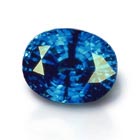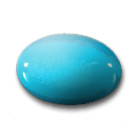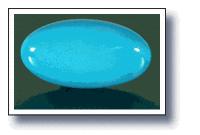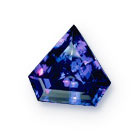The month of DECEMBER now has three birthstones that can
be worn to recognize this birth month. In addition to Blue Zircon
(faceted) and Turquoise (cabochon), the fall of 2005 introduced TANZANITE as the
first newly named birthstone in 50 years for the month of December.
Blue Zircon, Turquoise and
Tanzanite DECEMBER
BIRTHSTONE
Zircon: Brilliant but
Misunderstood
 Hindu poets tell of the
Kalpa Tree, the ultimate gift to the gods, which was a glowing tree covered with
gemstone fruit with leaves of zircon. Zircon has long had a supporting role to
more well-known gemstones, often stepping in as an understudy when they were
unavailable.
Hindu poets tell of the
Kalpa Tree, the ultimate gift to the gods, which was a glowing tree covered with
gemstone fruit with leaves of zircon. Zircon has long had a supporting role to
more well-known gemstones, often stepping in as an understudy when they were
unavailable.
In the middle ages, zircon was said to aid sleep, bring prosperity, and promote
honor and wisdom in its owner. The name probably comes from the Persian word
zargun which means "gold-colored," although zircon comes in a wide range of
different colors.
Natural zircon today suffers for the similarity of its name to cubic zirconia,
the laboratory-grown diamond imitation. Some don't realize that there is a
beautiful natural gemstone called zircon.
Zircon occurs in a wide range of colors but for many years, the most popular was
the colorless variety which looks more like diamond than any other natural stone
due to its brilliance and dispersion.
Today the most popular color is blue zircon. Most blue zircon, which is
considered an alternate birthstone for December, is a pastel blue, but some
exceptional gems have a bright blue color. Zircon is also available in green,
dark red, yellow, brown, and orange.
Zircon is mined in Cambodia, Sri Lanka, Thailand, Myanmar, Australia, and other
countries.
Zircon is one of the heaviest gemstones, which means that it will look smaller
than other varieties of the same weight. Zircon jewelry should be stored
carefully because although zircon is relatively hard, it can abrade and facets
can chip. Dealers often wrap zircons in individual twists of paper so that they
will not knock against each other in a parcel.
The wide variety of colors of zircon, its rarity, and its relatively low cost
make it a popular collector's stone. Collectors enjoy the search for all
possible colors and variations.
BACK
Turquoise
 Ancient and yet
always at the height of current fashion: that is Turquoise for you. Its
brilliant sky-blue belongs to the all-time favorite trend colors in the world of
fashion and jewelry.
Ancient and yet
always at the height of current fashion: that is Turquoise for you. Its
brilliant sky-blue belongs to the all-time favorite trend colors in the world of
fashion and jewelry.
In many cultures of the Old and New World this gemstone has for thousands of
years been appreciated as a holy stone, a good-luck-charm or a talisman. It is a
virtual "peoples’ gemstone”. The oldest proof for this lies in Egypt, where in
tombs from the period around 3000 B.C. there were found artifacts set with
Turquoise. In the ancient Persian Kingdom the sky-blue gemstones were originally
worn around the neck or on the hand as protection to ward off unnatural death.
If the stones changed their color, there was an imminent danger for the wearer.
However, in the meantime it has been uncovered that Turquoises may in fact
change their color, but this reaction is not necessarily an indication of danger
impending. The reason for the color change is rather the influence of light,
cosmetic products, dust or even the ph-value of the skin, which may all trigger
off chemical responses.
Turquoise will protect and
let you enjoy life
In earlier times Turquoises were sometimes thought responsible for the material
wealth of their bearers. For example, Persian philosopher Al Kazwini wrote: "The
hand wearing a Turquoise and using it as a sealing stone, will never be poor.”
Turquoises were loved as ornaments decorating turbans, often set in a border of
pearls, in order to protect the wearer from the "evil eye”.
They were used as talismans decorating daggers, scimitars or the horses’
bridles. Turquoise came to Europe only during the time of the crusades. And from
this period comes the name "Turquoise”, meaning simply "Turkish stone”.
Also in South, Middle and North America Turquoise has always been enjoying a
special position among gemstones. For example, the ancient Aztecs in Mexico used
to decorate their ceremonial masks with this stone, a "holy stone” in their
belief. The North American Indians, who are still producing quite a few pieces
of traditional silver jewelry set with Turquoises today, believed that the
gemstone the color of the sky would establish a direct connection between the
sky and the lakes.
At all times in history Turquoise was worn as protection to ward off the
influence of dark and evil powers. In former times thought to protect riders and
horses from accidental falls, they are nowadays considered the ideal good-luck
stones for aviators, flight staff and other professions which need special
assistance to ward off accidents.
In the contemporary teachings of the Healing Power of Stones, wearing Turquoise
is recommended to solve the problems caused by a depressed outlook on life. The
bright and happy color is supposed to lend self-confidence to subdued
personalities, and it is also very popular as a token of friendship, since
Turquoise is reputed to be responsible for faithfulness and reliable
relationships.
The blue from copper, the
green from iron
 Turquoise is a copper aluminum phosphate achieving hardness six, thus
considerably softer than quartz. It occurs naturally in all shades ranging from
sky-blue to grey-green, usually in such locations where copper is hidden in the
soil in high concentrations. However, only the best quality Turquoises show the
real turquoise color, which in ordinary stones is normally rather pale,
blue-green or greenish. The blue color is caused by copper, while the green
color is caused by iron or chromium. Often the material is veined or shows
spots, which depending on the respective occurrence are brown, light grey or
even black. These vivid, more or less regular patterns are called the spider
web. The micro-crystals are really tiny and almost not discernible with the bare
eye. Usually turquoise occurs as encrustation, in veins or as nodules or
nuggets. The most famous occurrences are situated in the USA, Mexico, Israel,
Iran, Afghanistan and China. The most beautiful of Turquoises in wonderful light
blue are found in Northern Iran.
Turquoise is a copper aluminum phosphate achieving hardness six, thus
considerably softer than quartz. It occurs naturally in all shades ranging from
sky-blue to grey-green, usually in such locations where copper is hidden in the
soil in high concentrations. However, only the best quality Turquoises show the
real turquoise color, which in ordinary stones is normally rather pale,
blue-green or greenish. The blue color is caused by copper, while the green
color is caused by iron or chromium. Often the material is veined or shows
spots, which depending on the respective occurrence are brown, light grey or
even black. These vivid, more or less regular patterns are called the spider
web. The micro-crystals are really tiny and almost not discernible with the bare
eye. Usually turquoise occurs as encrustation, in veins or as nodules or
nuggets. The most famous occurrences are situated in the USA, Mexico, Israel,
Iran, Afghanistan and China. The most beautiful of Turquoises in wonderful light
blue are found in Northern Iran.
Turquoise is only rarely facetted. Usually it is shaped as cabochons or as
beads, or even given a fancy cut.
Wax will lend Turquoise
resistance
Turquoises are relatively soft gemstones and thus quite sensitive. Since the
color may also fade out in the course of wearing, today even the top qualities
receive a waxing and subsequent hardening treatment. This procedure will make
the sensitive gemstone sturdier. Turquoises which have been sealed with
artificial resin are also available in large amounts and at competitive prices.
Their color appears fresh, and they show a high resistance. But one should be
careful, because many of these stones have been additionally dipped in color
before being sealed, and this coloring is a kind of treatment which according to
the rules set down by ICA must be indicated. In addition, there are also
so-called "reconstructed” Turquoises, which have been assembled from pulverized
Turquoise.
Due to their high sensitivity, then, almost all Turquoises have been treated to
preserve their beauty, however, the kind of treatment differs considerably. It
makes sense, then, that naturally beautiful stones which have simple been waxed
or hardened with artificial resin achieve higher prices and are more valuable
than such stones, which have received color-enhancement. Valuable Turquoise
jewelry should therefore best be purchased from a jeweler you can trust.
A piece of sky in your
hands
The best Turquoise quality shows a clear and light sky-blue. The color is highly
appreciated, with or without the fine regular spider web lines. The quality
decreases with the increase of green in color, and the increase of spots and
irregularities in the spider web.
Turquoise should be protected from cosmetics, heat and bright daylight. The
gemstone does not really appreciate sunbathing. It is recommended to clean it
from time to time after wearing with a soft cloth.
The color of a Turquoise will make you feel happy and relaxed, for it combines
the light blue of the sky with the invigorating green of the seas. It is so
unique that the language took the stones’ very name to describe it: Turquoise.
So if you decide on a Turquoise, you will hold a piece of the sky in your hands.
BACK
Tanzanite
 Tanzanite is a very
special and unique gemstone. World-wide it occurs only in one specific location.
Its blue color which shimmers in a slightly purplish hue is magnificent indeed.
Because of its unusually attractive flair it was easy for New York Jeweler
Tiffany’s to make it one of the most sought-after and popular gemstones in the
world.
Tanzanite is a very
special and unique gemstone. World-wide it occurs only in one specific location.
Its blue color which shimmers in a slightly purplish hue is magnificent indeed.
Because of its unusually attractive flair it was easy for New York Jeweler
Tiffany’s to make it one of the most sought-after and popular gemstones in the
world.
Its name reminds of the world-wide unique occurrence in the east-African state
of Tanzania. Africa – the name of this continent does not immediately remind us
of gemstones. Nevertheless, Africa is a continent from where many splendid and
beautiful stones find their way to the world markets. An example for this is
Tanzanite, which was enthusiastically celebrated after its discovery in 1967 as
"Gemstone of the 20th Century” The gemstone experts literally held their breaths
when they were shown the first deep blue crystals mined in the Merelani Hills
near Arusha in the north of Tanzania. Millions of years ago, metamorphous
slates, gneiss stone and quartzite shaped impressive flat insular mountains on
the wide planes near Mount Kilimanjaro. In the core of these unusual rises there
are stored the valuable crystals. For a long time they remained hidden for the
eyes of men, until one day some Massai-herdsmen passing by noticed crystals
sparkling in the sun and picked them up.
Today at Merelani the popular crystals are searched for in several, usually
smaller mines, to some extent by means of modern methods. Generally only smaller
grains are being found, but now and then the miners strike a lucky vein and
produce a larger crystal – much to the pleasure of the mine-owners and the
numerous Tanzanite enthusiasts everywhere in the world.
The Tanzanite trade is managed by many, usually small-scale licensed traders who
have built up good business relationships with gemstone firms in Germany, India,
Israel and the USA. An estimated 90 per cent of all Tanzanite traders are
registered members of the International Colored Stone Association ICA and thus
dedicated to the respective high ethical standards of ICA. In this way, then
this exclusive gemstone is not brought to the world markets via suspicious
back-street dealers, but in spite of its rarity is distributed via reliable and
trustworthy official channels to well-reputed gemstone-cutters, and then passed
on to the most important jewelers all over the world.
Actually only a blue
Zoisite ...
Tanzanite is in fact the blue variety of Zoisite gemstone. However, the hydrated
calcium aluminum silicate mineral achieves only hardness 6.5 to 7 on the Moh’s
scale, and is thus not very resistant. Therefore it should be worn with care,
never be cleaned by ultrasonic method and never come into contact with acids.
When New York Jeweler Company Tiffany was presented with the first Tanzanites
right after they had been discovered, they were immediately convinced: this
gemstone is a sensation! However, they recommended finding a new name for the
blue beauty, since the gemologically correct denomination "blue Zoisite"
reminded unfortunately of the word "suicide". So Tiffany's suggested the name
Tanzanite instead, derived from the place of occurrence, and the new name
quickly became established on the market. And it was in fact the firm of
Tiffany’s who introduced the stone to the public in a spectacular promotional
campaign two years after it had been discovered.
... but what a spectacular
color!
Spectacular and magnificent is the deep blue of Tanzanite, ranging from
ultramarine to a light purplish blue. The most coveted color is a blue which
shows a purplish hue shimmering around it, which is extremely spectacular in
sizes above ten carats. Typical for Tanzanite is the appearance of several
colors in one and the same stone: depending on the perspective, the stone
appears blue, purple, or dun yellow. Most rough crystals, however, show a
disturbingly large proportion of brownish-yellow, but the cutter may cure this
by carefully heating the stone in an oven to about 500°C. In the course of this
heating , utmost concentration is demanded, for it is essential to determine the
moment when the color turns blue. Heating is therefore a treatment which is
generally accepted in the trade, however, the rough stone has to be as free of
inclusions as possible, as otherwise the process will lead to fissures in the
stone.
Working with Tanzanites is a task which will cause even experienced cutters to
tread carefully, as the cleavage of the gemstone is very high in one direction.
The exclusive stone is cut in any imaginable shapes and forms, from classical
round cuts to imaginative designer cuts.
Tanzanite is always fascinating because of its unusual appeal that will hold
everybody in its thrall. The deep blue with the slight purple shade is one of
the most extravagant colors available. It symbolizes immaculate but unusual
elegance. Whoever purchases such a unique gemstone wants to be set apart from
the masses. Wearing it communicates self-confidence and individuality. The
almost magical color of a perfectly cut Tanzanite is not only attractive on
young women, it also emphasizes the individuality of a mature woman.
For Tanzanites in especially good qualities and larger sizes almost any price
will be paid by now. What is it that makes this stone so coveted? Is it only the
spectacular color? Well, it seems we must also take the exclusive origin into
account here. As the stone is found on one special location only in all the
world, it is especially valuable. After all, the desire to own something unique
and rare has always been a decisive criterion for assessing the value of special
gemstones.
BACK
HOME
LINKS
SPOTLIGHT ON TKPinc
FAQ
Gems and Metals
Directions To Our Store
 Hindu poets tell of the
Kalpa Tree, the ultimate gift to the gods, which was a glowing tree covered with
gemstone fruit with leaves of zircon. Zircon has long had a supporting role to
more well-known gemstones, often stepping in as an understudy when they were
unavailable.
Hindu poets tell of the
Kalpa Tree, the ultimate gift to the gods, which was a glowing tree covered with
gemstone fruit with leaves of zircon. Zircon has long had a supporting role to
more well-known gemstones, often stepping in as an understudy when they were
unavailable.
 Ancient and yet
always at the height of current fashion: that is Turquoise for you. Its
brilliant sky-blue belongs to the all-time favorite trend colors in the world of
fashion and jewelry.
Ancient and yet
always at the height of current fashion: that is Turquoise for you. Its
brilliant sky-blue belongs to the all-time favorite trend colors in the world of
fashion and jewelry. Turquoise is a copper aluminum phosphate achieving hardness six, thus
considerably softer than quartz. It occurs naturally in all shades ranging from
sky-blue to grey-green, usually in such locations where copper is hidden in the
soil in high concentrations. However, only the best quality Turquoises show the
real turquoise color, which in ordinary stones is normally rather pale,
blue-green or greenish. The blue color is caused by copper, while the green
color is caused by iron or chromium. Often the material is veined or shows
spots, which depending on the respective occurrence are brown, light grey or
even black. These vivid, more or less regular patterns are called the spider
web. The micro-crystals are really tiny and almost not discernible with the bare
eye. Usually turquoise occurs as encrustation, in veins or as nodules or
nuggets. The most famous occurrences are situated in the USA, Mexico, Israel,
Iran, Afghanistan and China. The most beautiful of Turquoises in wonderful light
blue are found in Northern Iran.
Turquoise is a copper aluminum phosphate achieving hardness six, thus
considerably softer than quartz. It occurs naturally in all shades ranging from
sky-blue to grey-green, usually in such locations where copper is hidden in the
soil in high concentrations. However, only the best quality Turquoises show the
real turquoise color, which in ordinary stones is normally rather pale,
blue-green or greenish. The blue color is caused by copper, while the green
color is caused by iron or chromium. Often the material is veined or shows
spots, which depending on the respective occurrence are brown, light grey or
even black. These vivid, more or less regular patterns are called the spider
web. The micro-crystals are really tiny and almost not discernible with the bare
eye. Usually turquoise occurs as encrustation, in veins or as nodules or
nuggets. The most famous occurrences are situated in the USA, Mexico, Israel,
Iran, Afghanistan and China. The most beautiful of Turquoises in wonderful light
blue are found in Northern Iran. Tanzanite is a very
special and unique gemstone. World-wide it occurs only in one specific location.
Its blue color which shimmers in a slightly purplish hue is magnificent indeed.
Because of its unusually attractive flair it was easy for New York Jeweler
Tiffany’s to make it one of the most sought-after and popular gemstones in the
world.
Tanzanite is a very
special and unique gemstone. World-wide it occurs only in one specific location.
Its blue color which shimmers in a slightly purplish hue is magnificent indeed.
Because of its unusually attractive flair it was easy for New York Jeweler
Tiffany’s to make it one of the most sought-after and popular gemstones in the
world.